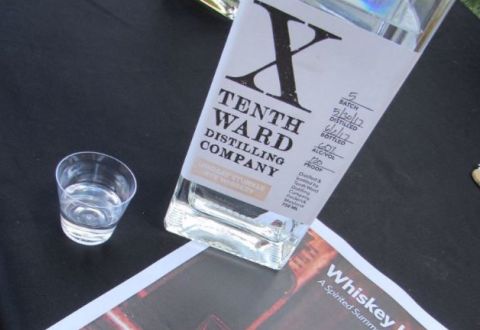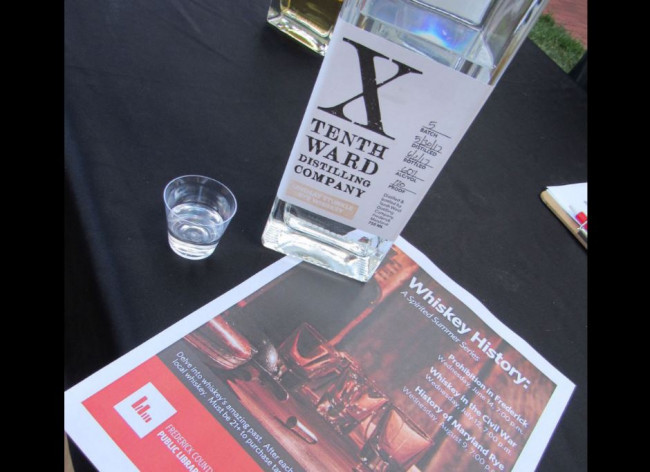“For those of us who appreciate history, this is like a step back in time,” said Kyle Pfalzer, co-founder of Frederick’s Tenth Ward Distilling Co., as he poured samples of the clear whiskey, unoaked and unaged, for the crowd that gathered last week on the lawn behind Heritage Frederick, the Historical Society of Frederick County. The Whiskey in the Civil War event was the second of a summer whiskey series in collaboration with Tenth Ward, Frederick County Public Libraries and the Historical Society of Frederick County.
Attendees at the Whiskey in the Civil War event were encouraged to abandon their whiskey stereotypes. Forget the image of injured men quaffing whiskey for anesthesia while the surgeon saws off his leg, said Jake Wynn, program coordinator for Frederick’s National Museum of Civil War Medicine. Before operations or after, doctors administered the spirit to get the heart rate up. Mixing alcohol and opium, they concocted the effective but addictive painkiller laudanum. But the notion of whiskey as anesthesia is a myth, Wynn said. In about 95 percent of the cases, doctors were using ether and chloroform to knock out their patients.
Both armies were stocked with anesthesia, Wynn added, but that doesn’t mean whiskey didn’t play a role in the hospital or on the battlefield.
The whiskey poured after Wynn’s discussion had the color and flavor of lightning, and as the crowd sipped samples of rye whiskey — a fraction of the daily ration for a Civil War soldier doing rigorous work like building trenches while on fatigue duty — it was easy to see why soldiers used this fiery liquor to fortify themselves before charging into battle. Whiskey was seen as a stimulant, Wynn said, and these fatigue duty laborers were issued about a shot a day.
Those who wanted more had to find it, either by raiding local homes or by finding saloons called grog shops willing to sell to soldiers, despite laws against it.
“Right here in Frederick, this is a town known for its booze during the Civil War,” Wynn said.
Whiskey had been a part of a soldier’s daily rations since the Revolutionary War, Wynn said, but that changed with President Andrew Jackson, who viewed booze on the battlefield as counterproductive. Non-fatigue duty officers switched whiskey for coffee.
Stories abound of drunken soldiers stumbling on the battlefield and pickled officers falling off their horses, Wynn said, but whiskey was also liquid motivation. After two failed attempts to take the Burnside Bridge at Antietam, he said, the Pennsylvania unit asked their colonel if they’d get whiskey if they succeeded.
“By God, if you take the bridge, we’ll give you a whole barrel,” the colonel promised, at least according to legend.
“They took that bridge,” Wynn said. “The night when the battle was over, they got their whiskey.”
After the war, when the soldiers returned home, the taste for whiskey followed them, Wynn said. Many veterans used it to cope with the trauma they experienced on the battlefield. Some drank themselves to death. Some saw their families fall apart and their debts spiral out of control.
“In the absence of something else to mask that pain, they’re going to use alcohol,” Wynn said.
Activists began protesting the grog shops. Women who began as abolitionists transformed into temperance crusaders.
“These social causes are really going to pick up steam as a result of the Civil War,” Wynn said.
The war between the North and South had ended. The war between wet and dry was just getting underway.




